The tale of Herne the Hunter is one shrouded in layers of mystery. For centuries, he was thought to be nothing more than a ghost that lurked around Windsor Great Park.
Cloaked in green and wearing antlers atop his head, Herne was naught more than a boogeyman. However, Herne may be more than a horned revenant. There is a high likelihood that the ghastly Herne could be the local manifestation of an ancient pagan god.
Table of Contents
Who is Herne the Hunter?
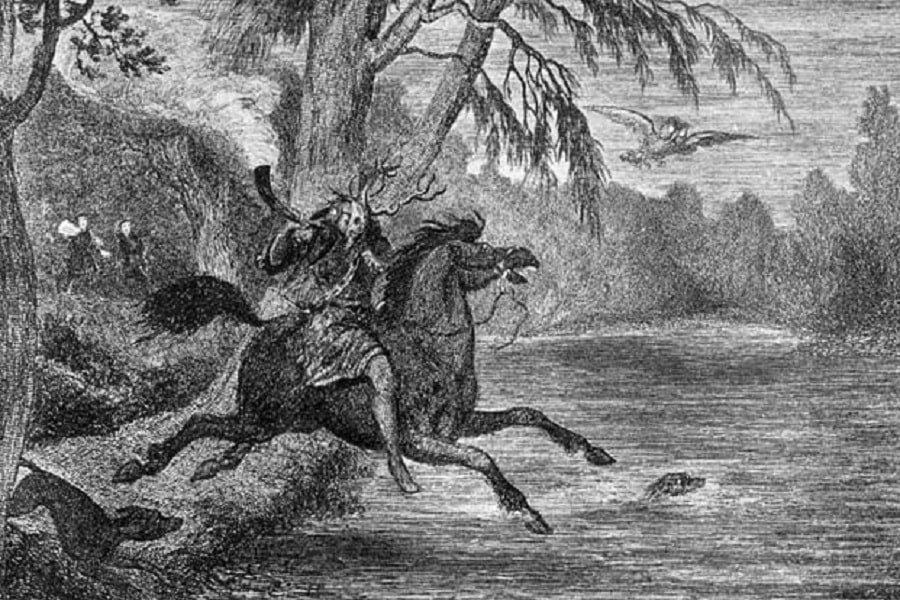
Herne the Hunter is a ghost from English folklore. He is first mentioned by William Shakespeare in his 16th-century play, The Merry Wives of Windsor. Before that though, we aren’t too sure how much of an impact Herne had on the local populous. Since there are no written accounts of Herne’s legend before Shakespeare, he could have simply been a creation of the famous playwright.
According to the Merry Wives, Herne the Hunter used to be a groundskeeper in Windsor Forest. He would haunt a particular oak tree (appropriately called Herne’s Oak) and sort of just torment people. He’d rattle chains and cause cattle to produce blood rather than milk. Later legends would accuse Herne of manifesting as a massive stag that romps through the woods at evening hours.
As one could imagine, Herne would be a total menace to early English society throughout the Tudor Period. Thankfully, he seems to be just a local legend.
Herne the Hunter is a local to the English county of Berkshire. Located in Southeast England, the forest he haunts lies towards the West of the county of Windsor. The flag of Berkshire is yellow and depicts a stag beneath the boughs of an oak tree. Herne is widely considered to be a local variation of the Wild Huntsman motif found within European folklore.
What’s the Deal with Herne’s Oak?
Herne the Hunter haunted a very specific oak tree, called Herne’s Oak. Only, not many people seemed to know exactly which oak tree was his favorite. What is known about the oak is that it was ancient; well-over 600 years old at the time of Queen Victoria. Some even date it back to the rule of Richard II, who ruled from 1377 to 1399.
If you were to visit Windsor Forest today, there would be a new Herne’s Oak. The original was either accidentally chopped down in the 18th century or blown over during a storm in the 19th century. The current Herne’s Oak was planted in 1906.
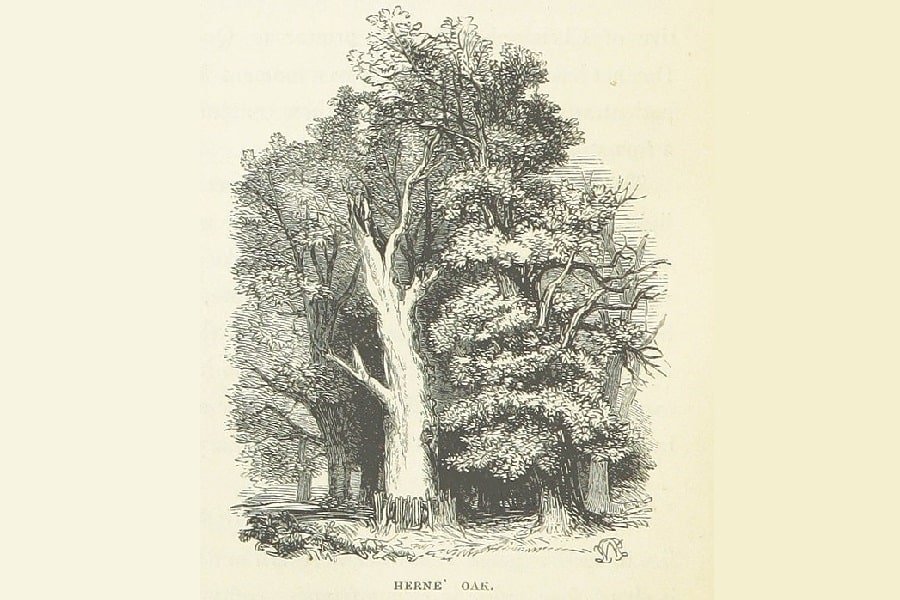
What is Herne the Hunter also Called?
Herne the Hunter has been referred to as “Horne” or “Horn.” This variation appears in early manuscripts of Shakespeare’s The Merry Wives of Windsor and has fanned the theory that this huntsman was nothing more than the playwright’s creation. To make the matter even more complicated, Horne was a somewhat common last name at the time. Aside from “Horne,” Herne’s name has also become interchangeable with the Celtic god of the wild hunt, Cernunnos.
Alright, now you may be wondering where the heck the similarities are between “Herne” and “Cernunnos?” At least with Horne, we could see it! It’d be only a letter off, that way. Although, if we go to the root of both characters (known and implied) we should get a better idea of the resemblance Herne has to the fantastical Lord of the Wild Things.
Is Cernunnos Herne the Hunter?
Over the years, the likeness Herne the Hunter bears to Cernunnos has been more and more obvious. Scholars suggest that the name “Herne” comes from Wodan’s alternative title, Herian, which is used during his role as a leader of fallen warriors. Cernunnos is likewise viewed as a variation of Wodan (Odin). Margaret Murray in her God of the Witches (1930) equates the two while noting that “Herne” was merely a colloquial title for the Celtic and Gallo-Roman Cernunnos.
What is even more compelling is that both mythological figures are connected to the oak tree. Of course, there is Herne’s Oak: the iconic tree that Herne haunted. There is also the ancient Oak that the Celtic god Cernunnos sits beneath in much of his imagery. The oak is depicted in many Celtic Ogham symbols and holds significance in Norse mythology, particularly for venerators of Thor. Oaks were held in such high esteem in many pagan religions that it is thought that sacred rites and rituals were held surrounded by oaks.
READ MORE: Pagan Gods from Across the Ancient World
As a quick review, both Herne the Hunter and the god Cernunnos…
- influence the natural cycle
- are associated with winter
- have been viewed as having power over life and death
- wear stag’s antlers
- are known for wearing green (or modest foliage)
- are quintessential wildman figures
- have an affinity for oak trees
- have been identified as leaders during the pagan Wild Hunt
READ MORE: 9 Gods of Life and Creation from Ancient Cultures
On another hand, the shared origin of Cernunnos and Herne can also be up to personal belief, regardless of past history. As with most religions, individuals interpret gods differently. Some individuals believe that the two entities are the exact same, while others believe they’re completely different.
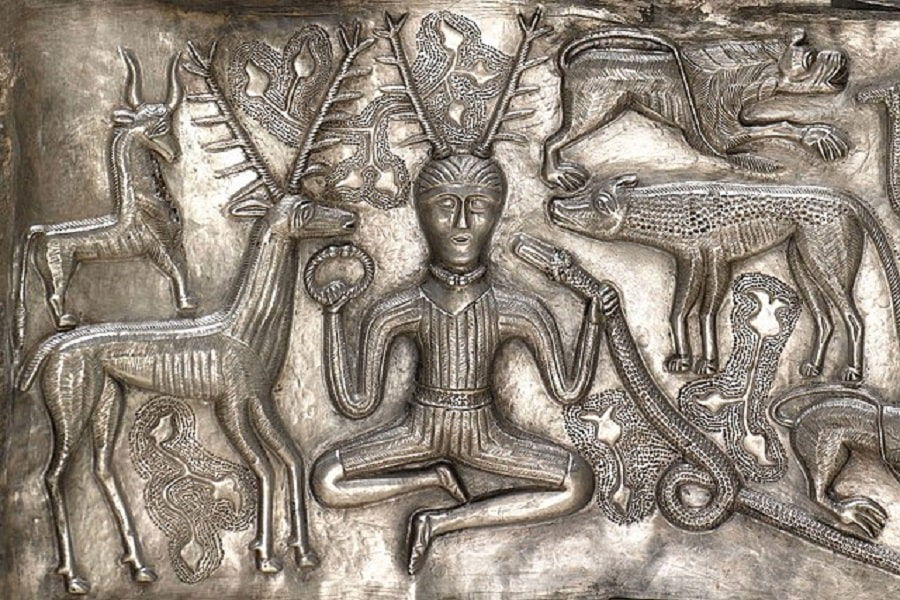
READ MORE: 10 Gods of Death and the Underworld From Around the World
Is Herne the Hunter a God?
We’ve established that Herne is a ghost (or a supernatural great stag, depending on your sources). Though, the development of his legends has turned him into more of a god than an apparition.
Neo-Pagans view Herne as a protective chthonic god. He protects hunters and prey, while also displaying some influence over the fertility of stags. Moreover, he promotes vegetation and is one of the supernatural leaders of the Wild Hunt.
Where Does Herne the Hunter Come From?
So, where did this ghost that haunts Windsor Great Park come from? Honestly, no one really knows! Shakespeare could’ve totally made this guy up. In fact, some scholars are convinced that Willy Shakes did.
Shakespearean scholar James Halliwell-Phillipps happened across early drafts of Merry Wives that shed some light on Herne. Herne was a hunter and more than that, he was caught poaching on the King’s land (oh-so scandalous). Also, the name “Herne” was instead written as “Horne,” which is a common surname around the area during Elizabethan times.
However, many scholars can’t help but notice the similarities between spooky Herne and the Irish deity Cernunnos. Pre-Christianization of England and the British Isles, much of the populace were Celtic Britons. Their religion, Celtic paganism, was overseen by druids. Despite this, those tribes to the south had far more contact with mainland Europe, especially the lands comprising Gaul, and incorporated their cultural beliefs into their own.
Cernunnos is a Gallo-Roman and Celtic god, with a cult found throughout Britain and Ireland. When the Romans conquered much of Briton in the 1st century AD, Cernunnos was one of the gods that continued to be venerated in the region, as seen on the Pillar of the Boatmen.
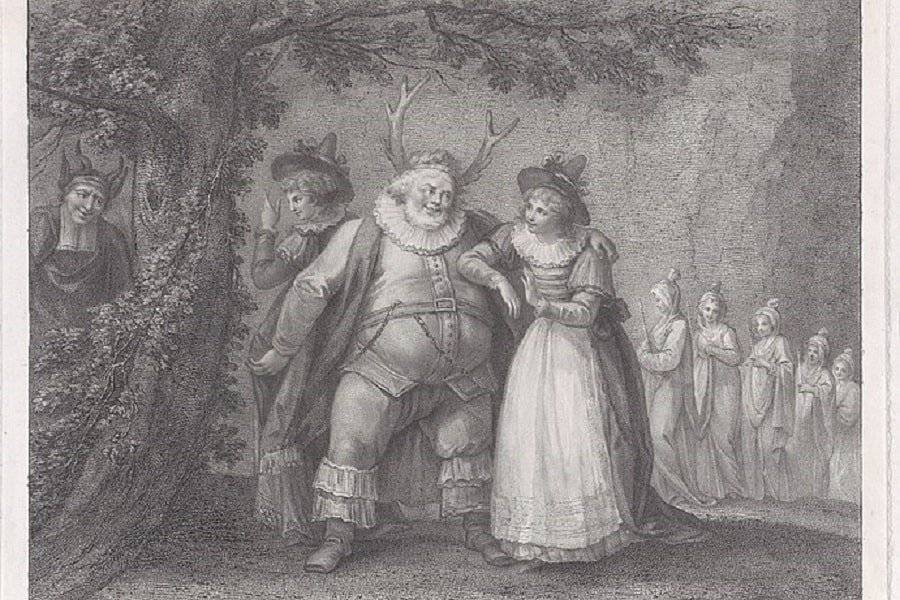
What Did Herne the Hunter Do?
The old tale of Herne the Hunter may originate from the 14th century, long before the reign of Queen Elizabeth I during which he gained notoriety. The Middle Ages was a bad time to be alive in England. There was the Great Irish Famine and the Black Plague; let’s not even touch on the immense social upheaval in the region as Scotland fought for independence, the Crusades simmered down, and anti-Semitism spiked. As absolutely brutal of a period this is, this may be the time and age in which the character of Herne the Hunter was conceived.
In one variation of his myth, Herne is a talented huntsman that gained favor from the king. Jealous of his newfound status, his friends turned on him. In another, Herne was an infamous poacher in Windsor Forest during the time of Henry VIII. No matter the tale, whatever Herne did leave him cruel. He became a callous specter, willing to disrupt the natural order of things for his own benefit.
Is Herne the Hunter Evil?
Herne the Hunter is considered evil, or at least malevolent. Much of this comes from the circumstances surrounding Herne’s death, which would’ve led to him becoming a vengeful ghost. Such a spirit would likely have evil inclinations.
Later expansion on Herne’s myth further cements him as an evil spirit. He withers plants with a single touch, can send gusts of wind with a wave of his hand, and has cows produce blood rather than milk. Also, legend has it that seeing Herne can bring death and despair. Much worse, Herne being seen threatens national disasters.
We’re not sure what you think, but that isn’t exactly something a nice guy would do. In Shakespeare’s words according to The Merry Wives of Windsor: “Herne the Hunter…a keeper here in Windsor Forest…all the winter-time, at…midnight / Walk round about an oak, with great ragg’d horns…he blasts the tree…takes the cattle…makes milch-kine yield blood, and shakes a chain in a most hideous and dreadful manner. You have heard of such a spirit, and well you know the superstitious idle-headed eld / Receiv’d…this tale of Herne the Hunter for a truth” (4.4). Right off the bat, the earliest mention of this figure doesn’t seem all too agreeable, either. “Hideous” nor “dreadful” are compliments.
The only saving grace of Herne the Hunter is his speculated relationship with Cernunnos, who isn’t evil. To the same extent, Neo-Pagans do not consider Herne the Hunter as evil, as much as he is fiercely protective of his lands.

What is the Pagan “Wild Hunt”?
The Wild Hunt is a repeating motif in northern European folklore. If you’ve ever stumbled across Peter Nicolai Arbo’s painting The Wild Hunt of Odin (1872), then you already have a pretty good image of what the Wild Hunt is. It’s haunting; it’s intense; it quite literally blurs the line between life and death.
Also known as a host or an assembly, the Wild Hunt is led by a culturally important folk hero. In the Germanic tradition, especially within Scandinavia, the Wild Hunt was led by the wise god Odin or a variation of the Proto-Indo-European god Woden. Other legendary leaders of the hunt include the mythical King Herla and the Upper Germanic goddess Perchta. The hunters in the assembly are often interpreted as ghosts of the dead.
Now, the tricky thing about the Wild Hunt is that no one was supposed to really see it. Witnessing the Hunt in action was considered a terrible omen. And it isn’t like crossing paths with a black cat sort of omen.
Seeing a Wild Hunt could mean that there is incoming famine, plague, or war. Alternatively, it could mean that the unfortunate viewer is fast approaching their demise. If none of those events occur, then the mythical hunters would tell the witness, “Hey, we know a spot,” and whisk them off to the Otherworld or the Underworld. You know, the usual hangout spots for specters.
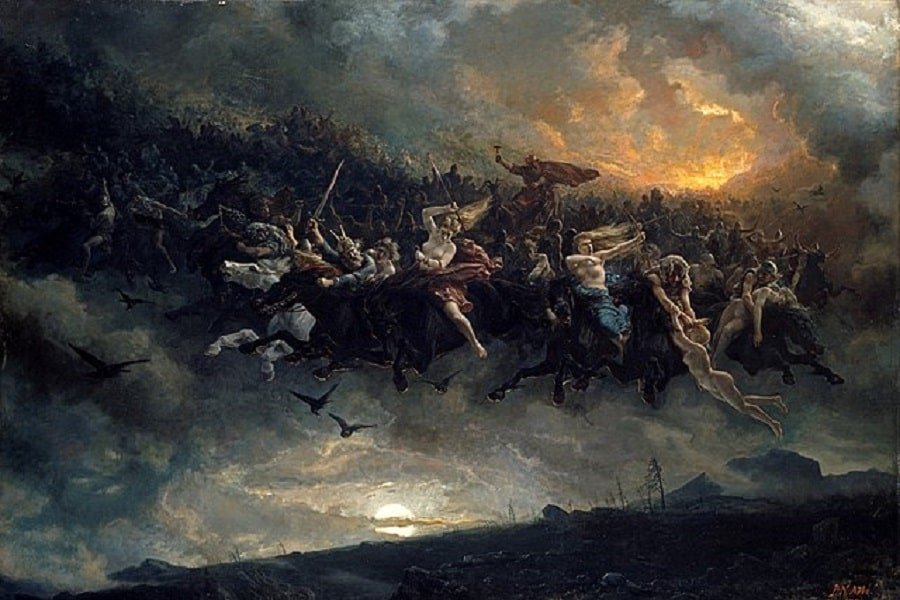
Who is the God of the Wild Hunt?
In Irish mythology, the god of the Wild Hunt is Cernunnos. The horned god is one of the more mysterious of the Celtic gods and goddesses, with little information about him surviving. He is revered amongst modern practitioners as the Lord of the Wild Things and the keeper of life and death.
Other leaders of the Wild Hunt include Herne, King Arthur, Eadric the Wild, Berchtold, Gwyn ap Nudd, Gudrun, Theodoric the Great, and Finn MacCool. The leader of the Hunt depended on the respective culture, though they were most all folk heroes. Interestingly enough, for something 12th-century historians dubbed a “Devil’s Romp,” there was a distinct lack of devils.
The German folklorist Ludwig Karl Grimm argues that the Hunt was originally a sacred march undertaken by the divine prior to the Christianization of Europe. That, rather than terror, the Hunt left blessings and abundance in its wake. So, it may have been much less of a “Devil’s Romp” and more of a righteous procession.
In Wicca, there are interpretations that the goddess Hecate instead leads the Hunt. Moreover, the Wild Hunt acts as an initiation through confronting the dark side of nature. Meanwhile, in his Hunting the Berserkers, Mark A. Hoffman likens the Wild Hunt to the winter celebration of Belsnickling, complete with “roaming, revelers who distributed charity…having a very festive, albeit notoriously drunk, time.” Huh: sounds like a pretty good time for something that apparently left tons of destruction in its wake.
Also, sorry to break the news to you all, but while this has begun as a ghost story, we’ve come full circle to…Christmas. That’s right: Old Saint Nick may have also been inspired by the legend of Wodan’s Wild Hunt. Perhaps Tim Burton’s Nightmare Before Christmas was onto something.